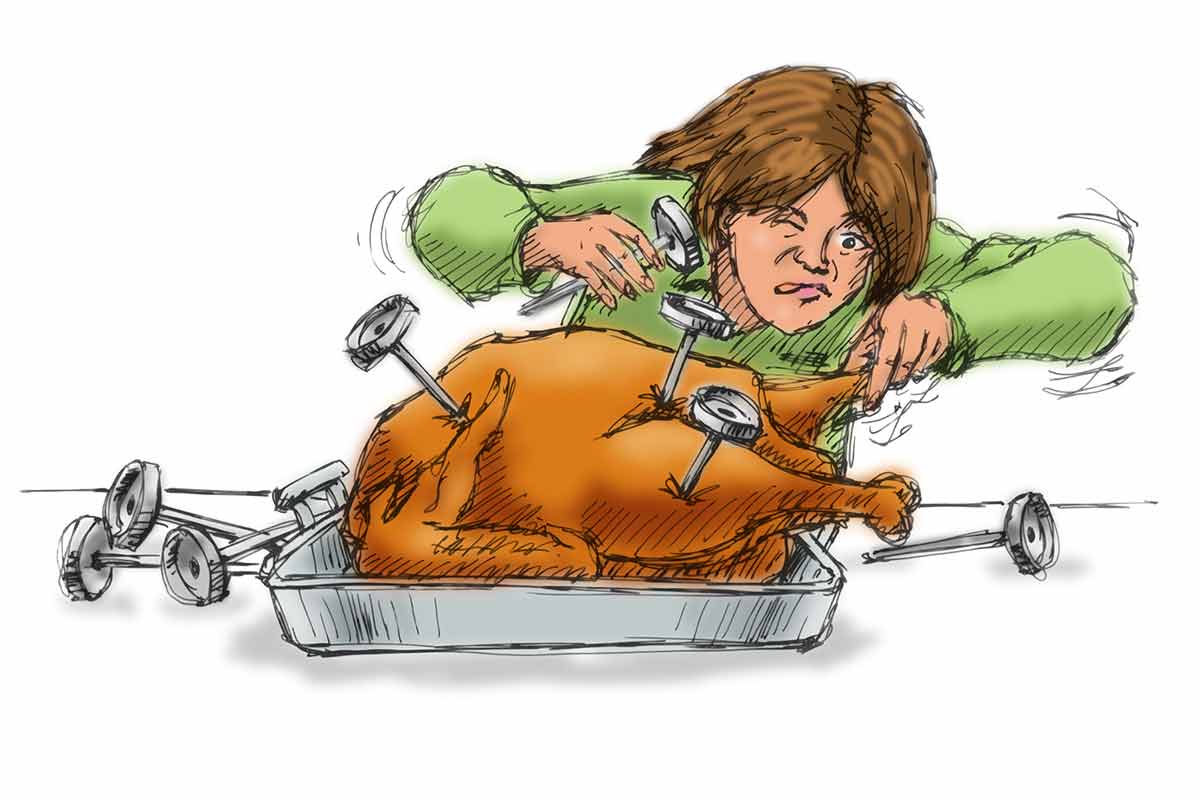

The pop-up timer popped. The majestic Thanksgiving turkey is burnished brown. The drumstick jiggles. Brandishing a knife, you smugly carve the first slice from the thigh—and then you see a trickle of pink. You rub your eyes, thinking surely it must be your imagination, and then look again.
No, it’s real.
Can you play dumb and pretend the darn thing isn’t slightly underdone?
Count your guests. Count your bathrooms. There’s your answer.
Here’s what went wrong:
- You relied on the plastic pop-up thermometer. This pathetic little device is ridiculously unreliable. As has been made abundantly clear by now, there’s no such thing as better living through plastics.
- You went by appearances, which can be deceiving. Didn’t dating teach you anything?
So. What to do?
Calmly put the bird back in the oven. Tent it with foil to insulate the sliced portion. Open another bottle of wine. Wait. And next time you check for doneness, use a meat thermometer, so you know for sure rather than guessing. We prefer the instant-read variety, rather than the kind with the long, dangly cord that stays in the oven and purportedly beeps when your bird is done. With the instant-read, there’s no cord to stick out of the door and allow even a smidgen of heat to escape. You’re looking for that moment when the thermometer reads 165°F (74°C). And be sure to check the bird in two, maybe three, places. Here’s where to poke:
The thigh. This tends to be the thickest, juiciest part of the turkey. If this is done, chances are the rest of the bird is done, too. Set the bird in its roasting rack on top of the stove so that the drumsticks are pointing away from you. On each side of the bird, note the large pillow of meat just under the drumsticks. Those are the thighs. Hold the probe end of the thermometer parallel to the drumstick and insert it into the center of the thigh meat, parallel to the drumstick. Push it in deeply—though not so deeply as to touch bone. If you strike bone (you’ll know if you do, as there’ll be unmistakable resistance), pull the probe out and try, try again. Hold the probe there until the temperature stabilizes, 5 to 10 seconds. Even if you read 165°F (74°C), take the temperature in the thigh on the other side, too, just for safety’s sake, before you breathe a sigh of relief.
The breast. If the turkey’s over 15 pounds, one of those bulked-up wonders we warned you about, you should check the breast as well as the thigh. The thickest part of the breast. This is far easier to find than the innermost thigh. It’s right in front of you, found up top, back from the legs. Insert the probe about halfway between the center breastbone and the drumstick, right into the juicy hump of meat. Push the probe in without forcing it. Again, avoid the bone.
The stuffing. The stuff you cram in the cavity isn’t necessarily done when the bird is; it most often takes longer. For one thing, it’s bathed in raw bird juice—which also needs to get to a safe temperature. For another, it may have eggs in it—which need to be cooked enough to get rid of any nasty pathogens. So it, too, needs to register 165°F (74°C). Insert the probe into the thickest part of the stuffing, far into the large opening of the bird. If the stuffing is still under temperature and the bird is browning too much, tent the bird loosely with foil until the stuffing is safe, too. (Don’t let us catch you trying to scoop out the stuffing into a baking dish and shove it back in the oven while you let the bird rest. It’s way too much hassle to try to get the stuffing out while the bird’s beastly hot without tearing the skin or otherwise damaging the bird. This also lets you bring the big, stuffed bird to the table for your own personal Rockwellian moment. Or just consider making the dressing outside the bird, not stuffing inside, yielding so many crunchy corners in the pan to be picked and pecked at in the kitchen while no one’s looking.)
And don’t worry about poking the bird more than once. It’s a myth to say “all the juices will run out.” Some will. About a half teaspoon per hole. If that’s all the juices in your big bird, you’ve got more problems than mere temperature. And don’t mind all the puncture marks. If they really bother you, carve the thing before you get it to the table.
Finally, refrigerate any leftovers fairly quickly. Within an hour of dinner, the bird should be back in the fridge. Otherwise, you’re back to counting bathrooms and guests. Originally published November 19, 2011.








